Category Archives: Studio One
Linzey Rae, Studio One and a Crab Costume Walk into a Kitchen…
Many PreSonus customers ask, “what’s the deal with the Cajun recipes in the back of PreSonus manuals?” May seem odd coming from an audio company, agreed. The truth is, we think it’s cool. We’re a Louisiana company and we’re proud of it. Good food and good music go hand in hand, especially in Louisiana.
We thought it would be fun to combine those things so we hooked up our friend and PreSonus artist Linzey Rae from the band The Anchor with a classic Louisiana recipe for gumbo for one of her Metal Kitchen episodes. Bon Appetit!
She pronounced “andouille sausage” correctly and that makes all of us happy. Can’t wait to hear what’s next from Linzey and The Anchor! Thank you for sharing and for using Studio One!
Subscribe to Linzey’s YouTube page HERE and follow along on all their musical ventures HERE!
Try out Studio One for free HERE!
VocALign Project 3 now Available for Studio One 3 at shop.presonus.com
Now available at shop.presonus.com: VocALign Project 3!
 VocALign Project 3 provides the latest version of the basic and legendary VocALign program that has been available since 1995, providing instant tight alignment of one audio signal to another. Simply capture a Guide signal with the right timing, capture a Dub signal to be aligned, press one button, and a new aligned Dub is generated and returned to your DAW.
VocALign Project 3 provides the latest version of the basic and legendary VocALign program that has been available since 1995, providing instant tight alignment of one audio signal to another. Simply capture a Guide signal with the right timing, capture a Dub signal to be aligned, press one button, and a new aligned Dub is generated and returned to your DAW.
Quietly legendary, VocALign’s early life included use in music production ranging from Shania Twain and Steely Dan to Black Eyed Peas; as well as in popular TV shows such as Friends and Seinfeld and in blockbuster films including Harry Potter and Lord of the Rings.
Click here to buy VocALign at shop.presonus.com
- ARA (Audio Random Access) is a pioneering extension for audio plug-in interfaces. Co-developed by Celemony and PreSonus, ARA technology enhances the communication between plug-in and DAW, and gives the plug-in and host instant access to the audio data.
- Synchro Arts and PreSonus have worked together to integrate VocALign tightly into Studio One with a simple, streamlined workflow to provide automatic, instantaneous time alignment of the selected audio signals.
Editors can save hours in the studio and let VocALign do the fine re-timing work automatically. Users simply select Guide and Dub audio events and drag and drop them into VocALign which instantly edits the Dub audio to match the timing of the Guide.
- Compatible with Studio One 3 Professional v3.3.1 or higher
- VocALign Project takes just seconds to automatically align two audio signals so that the timing of one matches the other
- Simple, intuitive operation
- Sophisticated pattern matching techniques
- Rejects guide track noise
- Work with different speakers, singers, words, instruments, and sounds
- The aligned audio can be auditioned within VocALign Project
- Scrolling, scalable display allows instant visual confirmation of sync
- User interface allows adjustment of selected audio regions for processing
- User-adjustable processing presets ensure optimal performance
- Pitch of aligned audio is unchanged
- Pace iLok account required when used in Studio One.
Chocolate Audio Pianos for Studio One
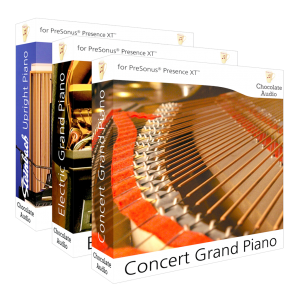
Looking for some of the best-sounding pianos you can get for Studio One? Look no further than this Piano Collection from Chocolate Audio. Three different pianos are available, each recorded with high-quality mics and expensive preamps. They also take advantage of Presence XT’s advanced scripting functionality to simulate the behavior of these beloved instruments as accurately as digitally possible.
If you’re not sure which piano is right for you and your music, check out the descriptions below. And if you’re still not sure after reading, get the combo pack of all three. The Chocolate Audio Piano Collection for Studio One is available only at shop.presonus.com.
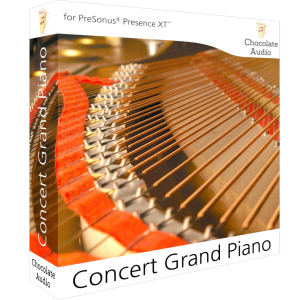 The Concert Grand:
The Concert Grand:
A recreation of a world-class concert grand piano sound as found in a Steinway D274 grand coda. This piano is gorgeous and rich in sound with a very well-balanced tone, very well fit for classical but equally at home with jazz and any scenario where a full piano sound is called for.
Great attention was paid to recreate this huge concert’s signature full and balanced sound through sampling. The sample set features 11 dynamic layers and a sustain pedal resonances layer, 12 release sample layers and pedal and key release noise effects tuned to perfection using Presence custom scripting. Studio One Professional users can load the multi-instrument preset which combines the two microphone sets for an even fuller control on its sound.
The Concert Grand offers two different phase-coherent recording setups: a player’s perspective recorded with Schoeps CMC6 microphones and a listener’s perspective recorded right at the edge of the lid with Neumann KM microphones, all matched-pairs going through Millennia preamps.
Electric Grand: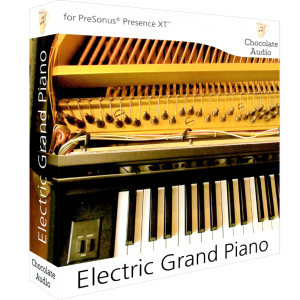
A top-notch rendition of a famous Japanese electric grand piano. At that time it was dubbed as “compact,” which it actually was when compared to the weight and size of an acoustic piano. Its mid-rangey character is due to the presence of a piezo pickup under the saddle of each string. Full restoration was carried out and proper tuning applied on the piano before sampling. A classic sound heard on countless hit records in the 70s-80s is now reborn inside Studio One.
Achieving a quality level on par with our goals from this piano was tough. The onboard electronics are noisy and the piano picks up a lot of ambient noise even if it’s electric (imagine a guitar with 88 strings!). Through attention and care, we managed to capture what we believe is the best rendition of this classic electric grand piano. The sample set features 12 dynamic layers, a sustain pedal resonance layer, nine release sample layers, and pedal and key release noise effects tuned to perfection using Presence custom scripting.
The Electric Grand was sampled direct from the output to the preamp and converter. All of the behavioral details of the piano have been re-created through the use of Presence XT’s custom advanced scripting.
Steinbach Upright: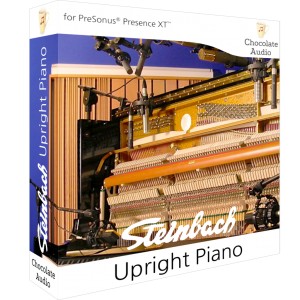
A high quality Italian-made upright piano sampled in full detail. The recording techniques used make this piano fit for many different uses, from classical to pop, country, rock and beyond.
This is a world-class piano recorded in a state-of-the-art studio with choice microphones and audiophile preamps and converters. Great attention was paid to recreate Steinbach’s signature full, organic, sound through sampling. The sample set features eight dynamic layers and a sustain pedal resonances layer, four release sample layers and pedal and key release noise effects, tuned to perfection using Presence custom scripting.
The Steinback Upright was recorded with two different phase-coherent setups: Blumlein stereo and Spaced stereo, recorded with Royer R121 matched-pair ribbon mics through Millennia preamps. Studio One Professional users can load the multi-instrument preset which combines the two microphone-sets for an even fuller control on its sound.
Last but not least:
The Chocolate Audio Pianos are compatible with Studio One 3.2 or later: Prime, Artist, and Professional editions.
All of the pianos in this family have the following onboard script controls:
- Tuning: 440/442 Hz
- Level control for Sustain Resonances, Pedal Noise and Release samples
- Velocity Curve control
- Hold, Decay, Release envelope controls
- Touch Response* control: sets the amount of pre-attack key noise heard, sets the attack time at higher settings.
New Studio One Loops from LoopMasters available at shop.presonus.com
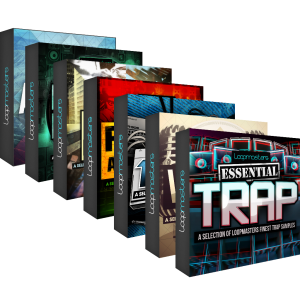 We just launched no fewer than seven new loop packs for Studio One, all from LoopMasters! These cover a lot of sonic territory including Ambient, Drum and Bass, Techno, Trap, and more.
We just launched no fewer than seven new loop packs for Studio One, all from LoopMasters! These cover a lot of sonic territory including Ambient, Drum and Bass, Techno, Trap, and more.
LoopMasters’.audioloops and .WAV files sound great, professionally produced at 24bit/44.1KHz, and are very reasonably priced. Get some inspiration for your next track for less than the cost of a lunch for two! Each of these packs contains 200 loops, (they are Loopmasters, after all) but you also get several drum kits and presets for Studio One’s Impact in every pack.
Click here to learn more about the LoopMasters sample packs—be sure to check out the audio demos to hear them for yourself!
Studio One 3.3 Available Now
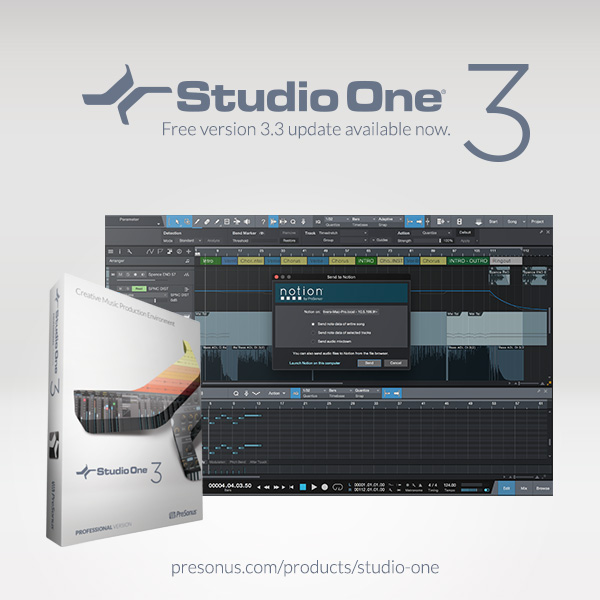 Studio One 3.3 is available now!
Studio One 3.3 is available now!
Just click “Check for updates” from the Start page in Studio One. This is a free update for all owners of Studio One 3, Artist or Professional.
Features and updates include:
- Single-click global effects on/off
- Deeper integration with Notion—compose in Studio One 3.3 and send note data to Notion 6 for editing and printing. You can also export audio to Notion 6.
- Multi-track drum editing improvements—instantly quantize using beat slicing
- Disable tracks, instruments, or plug-ins to improve CPU load and latency
- New Video Engine
- Click here to buy Studio One from shop.presonus.com
- Click here to find a dealer in the USA
- Click here to find a distributor outside the USA
Vintage Reverbs from Convology Now Available for Studio One
Convology Vintage Reverbs for Studio One
We’re proud to introduce this triple-pack of incredible vintage reverbs from Convology. These Add-ons, available at shop.presonus.com, have been meticulously modeled from many hard-to-find plate reverbs, spring reverbs, and digital reverb processors from across the globe. We can’t really overstate what an undertaking this was. The Convology Vintage Reverbs are available in a bundle pack, as well as individually.
These impulse responses work with Studio One 3 Professional’s Open AIR convolution reverb. Just download and install, and you’ll have all of the benefits of real-deal vintage ‘verb vibe… with none of the disadvantages:
- eBay expense
- Shipping damage and courier insurance claims
- Expensive replacement components
- Use of valuable studio space
- Scarce qualified repair personnel
Vintage Reverbs — Digital
This powerful collection of impulse responses brings back the sound of the early 80s reverb units. While many of today’s digital reverbs are renowned for their realistic quality, there’s an undeniable sonic mojo to some of the early digital efforts.
Full Listing of sampled reverb units
Digital Reverb 245 – (10 files) New York and Switzerland
Digital Reverb 246 – (20 files) Austria and Switzerland
Digital Reverb 248 – (16 files) Nashville, TN, and Denver, CO
Digital Reverb 250 – (26 files) Nashville, TN
Digital Reverb 245
The 245 was the 244 with the addition of pre-delay and a reflections settings. While the other German units incorporated some of these same reflection settings in algorithms, the 245 gave you the flexibility to really dial in those settings. When you look at these files, under the microscope, it’s interesting to see the early reflections (spikes) in the audio files. There was a great deal of audio engineering science that went into the reflections, how far or close together they would be, to emulate different rooms, halls, etc. The 245’s longest reverb time is around 5 seconds.
Digital Reverb 246
uses the algorithms from the 250 as does the 248, with a great deal of user control and flexibility. It also encompasses a slot for expanded memory similar to the 248. It has 6 program modes with a programmable low pass filter, reflections, and decay.
Digital Reverb 248
The 248 was the last unit made in this series and is treasured by many as being solid and quite nice sounding. The 248 was loaded with all kinds of presets and adjustable algorithms including, Baroque Church, Cathedral, Romanesque Church with numerous size rooms, halls and even stairwells, bathrooms and a preset called “Tiny Room.” The 248 is a very able processor and is used even today, like so many of these vintage units, by major recording artists around the world. One of our units was used by leading country artists such as Reba, Carrie Underwood, and Luke Bryan.
Digital Reverb 250 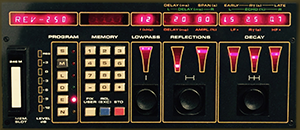
The first true DSP manufactured. The 250 uses 12-bit, 24k converters, low passed around 11Khz. This unit has large levers on top, weighs around 100 lbs and looks like it is from outer space – nicknamed the “R2D2.” No doubt, this is one of the finest DSPs from the era, with the few who own one of these remaining pieces of vintage outboard gear, still using them frequently and unabashedly. There is a 251 and 252 unit that are offshoots of this model. There were only around 250 of the original units made and then were adapted to the newer 251 interface and 252 upgrades with the 252 being a rack mounted version.
Vintage Reverbs — Plate
No two plate reverbs sound exactly alike. Even when made by the same company! Years of use, storage, re-conditioning, re-tuning, driver condition, pickups, and upgrades made to a plate unit each impart a sonic consequence. There’s a reason that some studios still reserve the space for a massive, heavy, expensive plate reverb—they tend to age like fine wines.
Full Listing of sampled reverb units
Plate Reverb Eco II (8 files) – Appleton, WI
Plate Reverb Eco III (13 files) – Sweden
Plate Reverb 140 Tube (16 files) – Nashville, TN
Plate Reverb 140 (19 files) – Finland
Plate Reverb 240 (15 files) – Los Angeles, CA
Plate Reverb Lawson (13 files) – Nashville, TN
Plate Reverb 140
For many, the 140s are viewed as king of the hill for a number of reasons. They were the first and came to market in the late 1950s. They tend to be a little warmer, tend to replicate, as they were originally designed, the sound of a concert hall and with limited EQing can for the most part, more readily replicate a dark, bright or a warm sounding room, etc. There are beautiful sounding files in every 140 model sampled—try them all along with very cool hybrid impulses that really are a solid addition to anyone’s convolution library!
Plate Reverb ECO
Tend to be brighter and a little more metallic sounding. Useful to bringing certain production elements out in the mix when you need it to cut through. These units were a little smaller than the Plate Reverb 140.
Plate Reverb 240
The 240 is darker sounding. Weighing 148 lbs, with dimensions of 1’ X 2’ X 2’. Some say better on shorter settings and for sound sources like drums. Originally designed as a way to make the original 140 (4’ X 8’) in a smaller and lighter box. It really was a technological feat for its time. They use a gold foil plate and are a hybrid between the original large 140 plate and early analog to digital rack mount and smaller floor units, although the 240 is totally analog.
Lawson
Tends to be brighter, iwth a bump in the lower mids tends to warm them up. This unit was designed and built by Gene Lawson who continues to make microphones today at his shop in Nashville, TN. His microphones are well regarded and his tenure in the business is remarkable.
Vintage Reverbs — Spring
This impressive collection of impulse responses brings back the famous sound of no fewer than 26 spring reverb units, sampled in 6 different countries including Britain, Canada, Netherlands, New Zealand, Scotland, and the USA.
Many pieces of gear included in this Add-on have been used by major recording artists, like tube springs that have been used by The Rascals, Van Morrison, and in James Brown’s famous “It’s a Man’s Man’s Man’s World.” (K-100 Spring)
General Overview
For many who grew up in the era of plates and springs, most were drawn to plates for very good reasons. After careful consideration and reaching out to studios around the globe for the most interesting vintage springs that could be found and acoustically captured, some of these springs are just absolutely gorgeous with the spring and electronics of the units, really creating some fantastic sounding reverbs–the 3D audio quality that many engineers aim to find.
If you’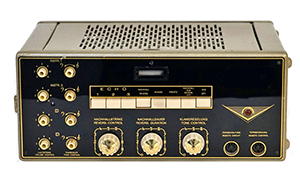 ve always fancied yourself a plate reverb individual, this library will definitely change your mind. There are springs of all kinds, and yes, there are some boingy ones—gotta have a few for that vintage guitar, lead vocal, and organ sound, right? There’s also mono and stereo versions, along with a variety of lush and warm-sounding springs that nearly sound like a plate—they deliver the “reflections from nearby walls” as only a spring can—when light tremor and flutter of the spring occurs.
ve always fancied yourself a plate reverb individual, this library will definitely change your mind. There are springs of all kinds, and yes, there are some boingy ones—gotta have a few for that vintage guitar, lead vocal, and organ sound, right? There’s also mono and stereo versions, along with a variety of lush and warm-sounding springs that nearly sound like a plate—they deliver the “reflections from nearby walls” as only a spring can—when light tremor and flutter of the spring occurs.
This spring reverb collection is complete with a wide range of springs, useful for a variety of applications. There are a good number of impulse response files in this library that you wouldn’t hesitate to apply to the lead vocal–they’re that good, and would absolutely compete with some of your favorite – digital or plate reverb presets. A number of leading engineers and producers use springs on a regular basis and some as their main “go-to” for reverb in general.
Click here to buy Vintage Reverb Collection at shop.presonus.com
Studio One, Metal and Shepherd’s Pie
You may be wondering what Studio One, Metal music and Shepherd’s pie have in common.
Well, her name is Linzy Rae. Linzy and her band, The Anchor, are the masterminds behind the viral video YouTube series “Metal Kitchen.” With over 1.3 million views on their first video, and 35K followers on Facebook, they caught our eye–and ear.
Check out her first video “The Ghost Inside makes Shepherd’s Pie” from December 2015.
“The Ghost Inside makes Shepherd’s Pie” from December 2015.
Linzey is the lead vocalist for The Anchor, a Melodic Metalcore band based in Denver, CO. They’re also big fans of PreSonus so we figured we could trade them an interview for some Cajun recipes. They agreed and everyone wins!
- What PreSonus products have you used and which do you currently use?
The band started out with an Audiobox USB 2X2 with a free version of Studio One 2 Artist. We eventually upgraded to the producer version because we loved it so much. Now we have Studio One 3 Producer.
- For what applications are you using Studio One Pro?
We have used Studio One Pro for our first two EPs in my band, The Anchor. We have used Studio one for our entire YouTube channel as well. It has worked great in our home studio.
- What led you to choose Studio One? Was it the company’s reputation, audio quality, ease of use, specific features, price, other factors?
We originally used it because we needed a USB interface. We were told the Presonus Audiobox 2X2 would be a great start! It came with Studio one Artist and we loved it because of its user friendliness. Also the all the tutorials have been extremely helpful.
- Having used Studio One, what do you like most about it?
We love it’s user friendliness, compatibility with vst’s and plugins. It also comes with great mixing tools as well as the Project Page is such help with some post mixing/mastering things.
- What Studio One features have proven particularly useful and why?
The project page is particularly helpful in putting final touches on songs.
- Any user tips or tricks or interesting stories based on your experience with Studio One?
Go watch the tutorials and Studio One Experts! It is so helpful!
- Any final comments about PreSonus and Studio One?
Studio One 3 is a great expansion to the already awesome Studio One 2 we had previously. We will never switch, and can’t wait to see what the future holds for PreSonus.
I started uploading some covers to YouTube about a year ago. Now we consistently upload covers on a weekly or biweekly basis. We have videos such as Metal Kitchen, Scream It Like A Girl, and Pop Goes Metal.
- Where did you get the idea for Metal Kitchen?
We were in the studio and someone was going to order Chinese food for dinner. While I was in the recording booth, they asked me what I wanted to eat and I screamed “crab cheese wantons,” which created a running joke. Afterwards, our friend made a joke saying that I could write a recipe into one of our songs and people wouldn’t know the difference (Since the common opinion of metal music is that you can’t understand what the vocalist is saying). Then the idea sort of grew from there.
- It went viral–what’s that like?
The video completely caught us off guard it was amazing and also scary at the same time. We have never had so much attention on us all at once!
- What’s next for Metal Kitchen?
We just released a Metal Kitchen about making Black Bean Burgers featuring Miss May I’s song, IHE. For the next metal kitchen we are thinking about making Tacos to an All That Remains songs. Metal Kitchens format probably won’t change that much but we have a lot of other cool ideas that we can’t wait to try out!
- How can we find you online?
- Youtube: youtube.com/c/linzeyrae
- Facebook for The Anchor: https://www.facebook.com/theanchorband
- Follow The Anchor on Instagram: @the_anchor_band
- Follow Linzey on Instagram: @xlinzeyraex
- Follow The Anchor on Twitter here: @theanchorband
- Follow Linzey on Twitter here: @xlinzeyraex
Try out Studio One for free like these guys did HERE! Who knows, you may be the next YouTube sensation! Stranger things have happened…
e-Bass Collection 30% off at shop.presonus.com in June 2016
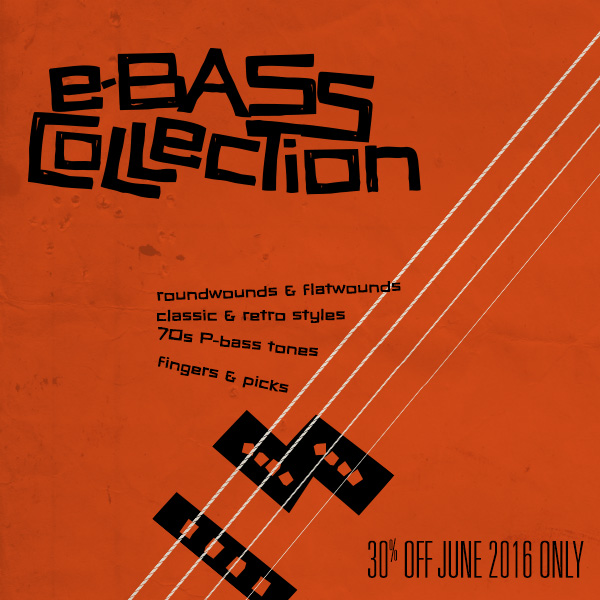 Only in June 2016—we’re offering 30% off of any item in the entire line of eBass Add-ons for Studio One 3. These recordings of a real-deal 1970s P-bass have been recorded in immaculate detail. Make no mistake—this isn’t a one-sound-per-MIDI note sample pack like that SoundFont from 1998 that you found on some “Free samples” website. There is a LOT for you to work with here—the packs include many different right-hand dynamics, left hand positions, hammer-ons, slides, dead notes and harmonics. There’s also a bevy of scripting at hand here, including valuable presets for you keyboardists out there who want to emulate bass playing via MIDI. Last but not least, each pack includes Musicloops in a variety of styles, including MIDI note data and effects chains per Musicloop.
Only in June 2016—we’re offering 30% off of any item in the entire line of eBass Add-ons for Studio One 3. These recordings of a real-deal 1970s P-bass have been recorded in immaculate detail. Make no mistake—this isn’t a one-sound-per-MIDI note sample pack like that SoundFont from 1998 that you found on some “Free samples” website. There is a LOT for you to work with here—the packs include many different right-hand dynamics, left hand positions, hammer-ons, slides, dead notes and harmonics. There’s also a bevy of scripting at hand here, including valuable presets for you keyboardists out there who want to emulate bass playing via MIDI. Last but not least, each pack includes Musicloops in a variety of styles, including MIDI note data and effects chains per Musicloop.
There are four packs in the e-Bass collection: Vintage Finger, Vintage Pick, Classic Finger, and Classic Pick. They’re also available in an all-in-one combo pack.
For more details on the incredible depth of the eBass collection, click here—but here’s a taste:
“We used a Millenia TD-1 tube channel for the Vintage Bass instruments, and an Avalon DI preamp for the Classic Bass. We also recorded the bass via an Ampeg SVT top with 112 speaker, just as a sound reference. However, we ended up using only the DI signals for our eBass instruments. The DI signal provides great flexibility for additional processing with amp simulators and EQ, so the reference amp recording was a tremendous help when we designed the Instrument+FX presets—we could always compare them to the real thing. Strings were medium 045-105 round-wound for the classic and the same gauge flat-wound strings for the vintage. The pickup set was the original from 1975.”
The eBass collection is available for all editions of Studio One 3: Artist, Professional, and Prime, and can be purchased on shop.presonus.com or directly from inside Studio One.
Tips and Tricks in Studio One from DJ Headhunterz—part 2.
Obviously, Willem Rebergen, or better known as DJ Headhunterz, is an incredibly talented EDM artist. A part of his genius is a result of his detailed understanding of the functionality of Studio One 3.2.2 and the ease he’s reached working with the DAW. After our initial conversation with Rebergen a couple months ago, we realized that he is a wealth of knowledge that we would love to hear more from—and we knew you would, too!
Here’s part 2 of tips and tricks for Studio One users from DJ Headhunterz!
“I’m not over exaggerating when I say that Studio One brought back the fun of making music for me,” Rebergen states. “I finally experienced what it feels like to ride the creative wave without constantly falling off it. Studio One motivates me to keep perfecting my workflow and I keep discovering new ways to do so every week.”
Rebergen starts off with tips that will ensure an easy, creative flow with Studio One. “If I were to give a tip it would be to make full use of the browser features and the MusicLoop feature. When I finish a song I completely undress it and save all sounds I made in the form of channel presets,MusicLoops and audio files. With every song I make my library expands and whenever I’m in the creative process I can recall any sound I am looking for without having to get into sound designing or endlessly searching through sample libraries. I make sure that every sound I save in MY library is on point. So they rarely need a lot of tweaking to fit into a song and I can just get on with concentrating on the creative part.”
“On the other hand I spend whole days making new sounds, collecting new drum samples, tweaking them etc. So that when I start a song, I’m loaded with content where I can just pick from very quickly.” Rebergen goes on to say, “Another thing I do is I keep an app open on the side called sticky notes where I type down all my newly made key commands (yes I constantly make new ones). I then force myself to use them all the time so they become a natural part of my workflow. Key commands make everything so much quicker and Studio One allows for using them for almost anything.”
Rebergen goes on to share general production tips that have worked for him over the last decade.
- Another thing that I have learned over time, and often read but always somewhat ignored, is that it is absolutely crucial to work with the right sounds. So often, I have found myself trying to fit things in a mix that simply did not fit. It’s very useful to learn to be honest to yourself when making music. Even if you’ve spent hours on making something. Those couple of hours don’t mean anything when you listen to your song by the time it gets released months later. Try to be alert and not be afraid to throw stuff away. It can open up for new ideas when you clean up.
- Nowadays more and more I make sure I have my pallete of sounds ready when I start a song. So that I don’t stumble upon these issues so much. I make sure the sounds are right so that it really comes down to the idea of the song at this point.
- Some tips on making saw leads like I often do in my tracks. I love to use chords underneath but I also love using portamento. So to keep that intact, I just make 3 copies of my lead, nowadays mostly Spire or Serum and I play on each one a note of the chord. This way I can still play a chord while maintaining the glides that are a big part of how the melody is expressed.
- Set the portamento so that it’s only triggered when two notes overlap so that you have complete control over when and how much it glides. I find that using this function instead of pitch bend automation feels more natural because I assume it has a different curve to it.
- Also in the synth itself I often link an envelope to the pitch of the sound and give it a very short attack and set it to about 2 semitones down. So that each note has just a slight pitching up in the beginning. This also brings more expression into the lead sound and makes it less static.
- Find the sweet spot with detuning. LFOs can also help for nice detuning without making it sound too false.
One last reminder from Headhunterz before we wrap. “Keep a beginner’s mind and acknowledge that the learning process is endless. I still feel like a noob sometimes. But I’m very passionately curious, I always want to keep discovering new ways.”
Keep an eye out for more from Headhunterz with part 3 of this series coming soon.
- Follow HeadHunterz on Instagram!
- Follow HeadHunterz on Twitter!
- Studio One 3 is 25% off in June 2016, including upgrades! Click here for more.
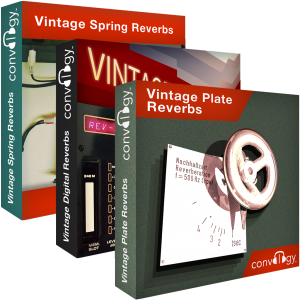
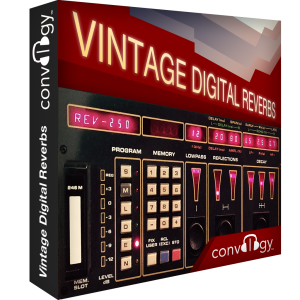
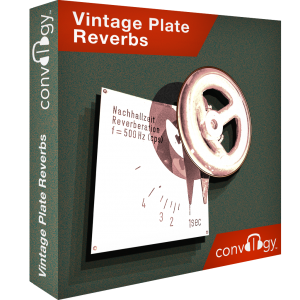
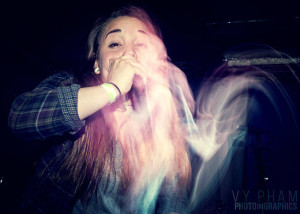

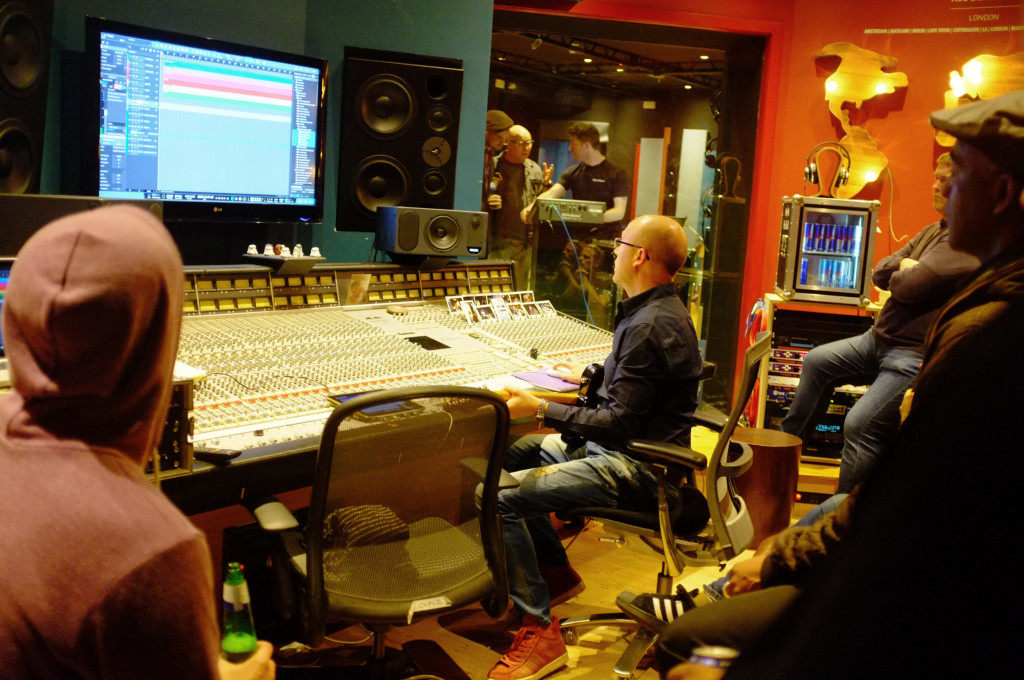 Following on from the huge success of the first event, this is the second PreSonus Studio One 3 Pro Producers event at Red Bull Studios, London. This just in: Arnd Kaiser, The General Manager at PreSonus Software will be joining us at this event and be able to take questions on Studio One and listen to your ideas about future development!
Following on from the huge success of the first event, this is the second PreSonus Studio One 3 Pro Producers event at Red Bull Studios, London. This just in: Arnd Kaiser, The General Manager at PreSonus Software will be joining us at this event and be able to take questions on Studio One and listen to your ideas about future development!